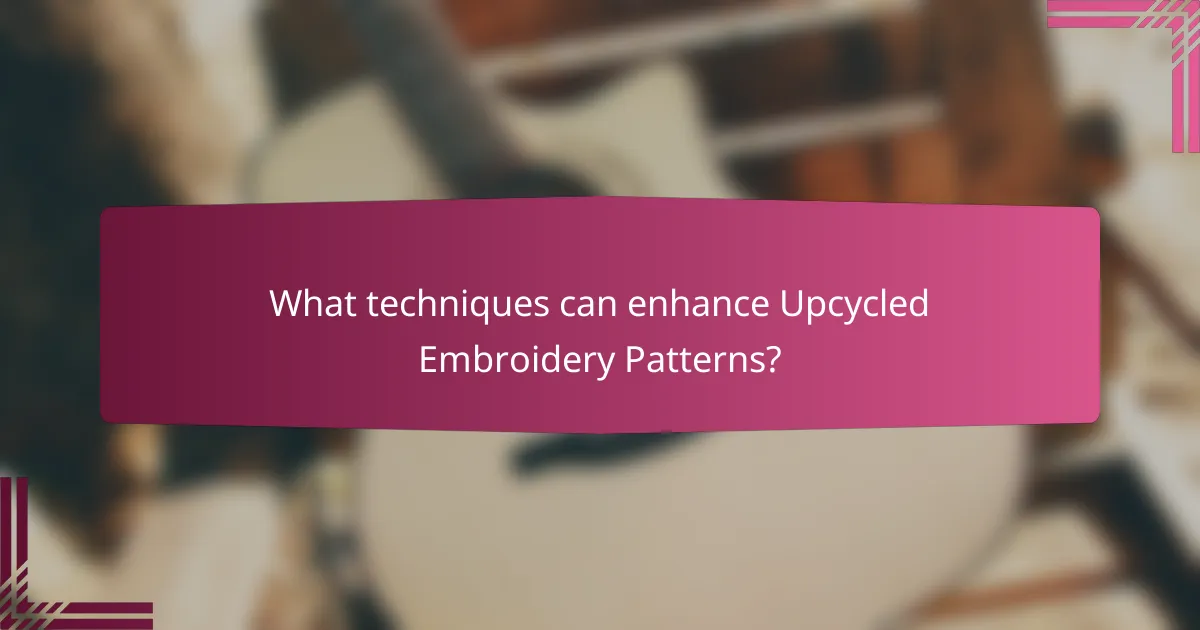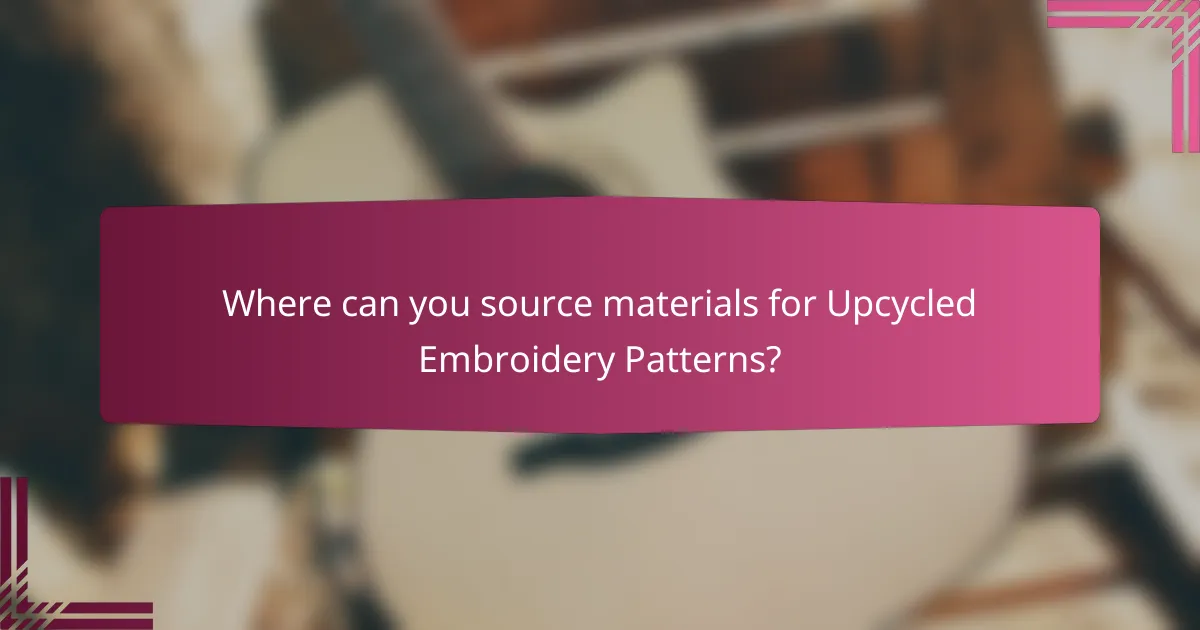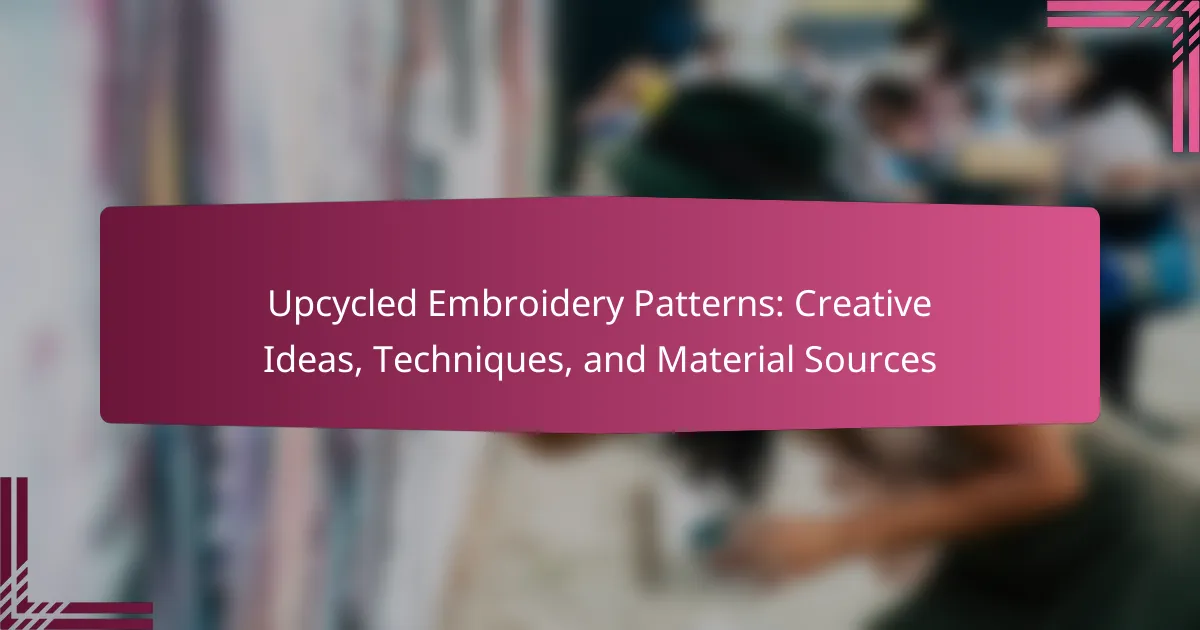
What are Upcycled Embroidery Patterns?
Upcycled embroidery patterns are designs created using repurposed materials. These patterns often utilize old fabrics, garments, or textiles that would otherwise be discarded. The practice promotes sustainability by reducing waste. Upcycled embroidery can incorporate various stitching techniques to enhance the aesthetic of the reused materials. This method allows for creativity and individuality in embroidery projects. Many artisans create unique pieces that reflect personal style while contributing to environmental conservation. The trend aligns with growing interest in eco-friendly crafting practices.
How are Upcycled Embroidery Patterns created?
Upcycled embroidery patterns are created by repurposing existing fabrics and materials. First, individuals select old textiles, such as clothing or linens. These fabrics are then cleaned and prepared for use. Next, designers sketch or plan their embroidery designs on paper or directly on the fabric. Afterward, the embroidery process begins, utilizing various stitches and techniques to embellish the fabric. Upcycling not only reduces waste but also adds unique character to the patterns. This method promotes sustainability in the textile industry by extending the life of materials.
What types of materials can be upcycled for embroidery patterns?
Fabrics, clothing, and linens can be upcycled for embroidery patterns. Common sources include old t-shirts, jeans, and tablecloths. Additionally, vintage sheets and pillowcases are often used. These materials provide unique textures and colors. Upcycling reduces waste and promotes sustainability. Many artisans prefer using remnants from previous projects. This practice encourages creativity and resourcefulness in crafting.
What techniques are commonly used in creating upcycled embroidery patterns?
Common techniques used in creating upcycled embroidery patterns include patchwork, appliqué, and free-motion stitching. Patchwork involves sewing together pieces of fabric to form a new design. This method utilizes scraps from old garments or textiles. Appliqué entails stitching a piece of fabric onto a base fabric to create designs. This technique allows for intricate patterns and textures. Free-motion stitching enables the embroiderer to move the fabric freely under the needle. This technique allows for creative, fluid designs that can incorporate various fabrics. Each of these techniques enhances the uniqueness of upcycled embroidery patterns. They promote sustainability by repurposing materials.
What are the benefits of using Upcycled Embroidery Patterns?
Upcycled embroidery patterns offer several benefits. They promote sustainability by reducing waste from discarded textiles. Using upcycled materials conserves resources and minimizes environmental impact. Additionally, these patterns often have unique designs, adding originality to projects. They can also be cost-effective, as they utilize materials that might otherwise be thrown away. Moreover, upcycled embroidery supports creative expression, allowing artists to experiment with diverse textures and colors. This practice can foster a sense of community, as many makers share techniques and ideas online. Finally, upcycled patterns can enhance skills in resourcefulness and innovation in crafting.
How do Upcycled Embroidery Patterns contribute to sustainability?
Upcycled embroidery patterns contribute to sustainability by reducing waste and promoting resourcefulness. They utilize discarded textiles, preventing them from ending up in landfills. This practice conserves resources needed for new fabric production. Additionally, upcycling encourages creativity and innovation in design. By transforming old materials, it fosters a culture of reuse and sustainability. According to the Ellen MacArthur Foundation, the fashion industry generates significant waste, highlighting the importance of upcycling. Upcycled embroidery patterns thus play a crucial role in minimizing environmental impact.
What unique aesthetic qualities do Upcycled Embroidery Patterns offer?
Upcycled Embroidery Patterns offer distinct aesthetic qualities such as individuality, texture, and sustainability. Each pattern is unique due to the diverse materials used, which often include remnants from various fabric sources. This results in a visually rich tapestry of colors and patterns. The use of recycled materials also adds an organic texture that enhances the overall visual appeal. Additionally, these patterns often convey a story or history, making each piece meaningful. The combination of these elements creates a striking contrast to mass-produced textiles. Upcycled embroidery promotes an eco-friendly approach, appealing to those who value sustainability in art and fashion.

What techniques can enhance Upcycled Embroidery Patterns?
Techniques that can enhance upcycled embroidery patterns include layering fabrics, using contrasting thread colors, and incorporating mixed media elements. Layering fabrics adds depth and texture to the design. Contrasting thread colors create visual interest and highlight specific areas. Mixed media elements, such as beads or buttons, can introduce unique textures and enhance the overall aesthetic. These techniques not only improve the appearance but also promote creativity in upcycling projects.
How can layering techniques improve the design of Upcycled Embroidery Patterns?
Layering techniques enhance the design of upcycled embroidery patterns by adding depth and texture. These techniques involve stacking multiple fabric layers or thread colors. This creates a more dynamic visual appeal. Layering can also introduce contrasting elements, making designs more interesting. Additionally, it allows for the incorporation of various materials, enhancing sustainability. For instance, combining different fabrics can showcase unique textures. This method can lead to innovative designs that stand out. Ultimately, layering techniques elevate the overall aesthetic of upcycled embroidery patterns.
What stitches are best for creating texture in Upcycled Embroidery Patterns?
The best stitches for creating texture in upcycled embroidery patterns include French knots, satin stitches, and chain stitches. French knots add dimension and visual interest. They create small raised dots that enhance texture. Satin stitches provide a smooth, shiny surface. This stitch works well for filling shapes and creating a plush feel. Chain stitches offer a rope-like effect. They can be used for outlines or decorative elements, adding depth to the design. These stitches are commonly used in textile art. Their versatility allows for creative expression in upcycled embroidery.
How can color combinations impact the overall look of Upcycled Embroidery Patterns?
Color combinations significantly influence the overall look of upcycled embroidery patterns. They can create contrast, harmony, or visual interest. For instance, complementary colors enhance each other, making the design pop. Analogous colors provide a cohesive and soothing effect. The choice of colors can also evoke emotions; warm colors convey energy while cool colors promote calmness. Research shows that color theory plays a crucial role in design aesthetics. A well-considered color palette can elevate the perceived value of upcycled pieces. Therefore, selecting appropriate color combinations is essential for impactful embroidery patterns.
What innovative methods can be applied to Upcycled Embroidery Patterns?
Innovative methods that can be applied to upcycled embroidery patterns include using digital design software to create unique patterns. This allows for precise customization and intricate designs that traditional methods may not achieve. Another method is incorporating mixed media, such as combining embroidery with fabric painting or appliqué. This enhances the visual appeal and texture of the final piece.
Utilizing sustainable materials, like repurposed fabrics and threads, is also crucial. These materials reduce waste and contribute to eco-friendly practices. Additionally, employing techniques like free-motion embroidery can add a unique artistic touch. This method allows for more freedom in design and creativity.
Lastly, collaborating with local artisans can bring fresh perspectives and techniques into the upcycled embroidery process. Such collaborations can lead to innovative patterns that reflect cultural heritage and craftsmanship.
How can digital tools assist in designing Upcycled Embroidery Patterns?
Digital tools can significantly assist in designing upcycled embroidery patterns. They allow for easy manipulation of designs and patterns. Software like Adobe Illustrator enables users to create and edit intricate patterns digitally. This reduces the time spent on manual design processes. Additionally, digital tools can help visualize how patterns will look on various fabrics. Programs can simulate stitching effects and color combinations. This aids in making informed decisions before actual stitching. Furthermore, online platforms provide access to a community of designers for inspiration and collaboration. These tools enhance creativity and efficiency in the design process.
What role does hand embroidery play in enhancing Upcycled designs?
Hand embroidery significantly enhances upcycled designs by adding unique artistic elements. It transforms basic materials into intricate, one-of-a-kind pieces. This technique allows for personalization, making each item distinct. Hand embroidery can also reinforce the structural integrity of upcycled fabrics. It provides texture and visual interest, elevating the overall aesthetic. Furthermore, it promotes sustainability by utilizing leftover materials creatively. According to a study by the Textile Research Journal, hand-stitched embellishments can increase the perceived value of upcycled items. This practice supports the slow fashion movement, encouraging mindful consumption.

Where can you source materials for Upcycled Embroidery Patterns?
You can source materials for upcycled embroidery patterns from thrift stores and fabric scraps. Thrift stores often have a variety of old clothing and linens suitable for repurposing. Fabric scraps can be collected from previous sewing projects or local sewing groups. Additionally, online marketplaces like Etsy or eBay offer vintage textiles. Community swap events or craft fairs also provide opportunities to find unique materials. These sources support sustainable practices by reusing existing fabric and reducing waste.
What types of fabric are ideal for upcycling in embroidery?
Cotton and linen are ideal fabrics for upcycling in embroidery. These materials are durable and easy to work with. They hold embroidery stitches well and provide a stable surface. Denim is another excellent choice due to its strength and texture. Upcycled denim can add a unique look to embroidery projects. Silk and wool can also be used for their luxurious feel. However, these fabrics may require more care during stitching. Overall, a variety of fabrics can be upcycled for embroidery, allowing for creative expression.
How can thrift stores and community donations be utilized for sourcing materials?
Thrift stores and community donations can be utilized for sourcing materials by providing low-cost or free fabrics and supplies. Thrift stores often carry a variety of textiles, such as clothing, linens, and upholstery, which can be repurposed for embroidery projects. Community donations can include leftover fabric scraps, old garments, and crafting supplies from local residents. These sources not only offer diverse materials but also promote sustainability by reducing waste. Utilizing these resources can significantly lower project costs while encouraging creativity in upcycling. Many crafters report finding unique patterns and textures in thrifted items that inspire their work.
What online resources are available for finding upcycled materials?
Online resources for finding upcycled materials include websites and platforms dedicated to sustainability. Websites like Freecycle and Craigslist allow users to give away or find free items. Etsy features sellers who offer upcycled materials for crafting. Facebook Marketplace provides local listings for second-hand goods. Pinterest is a source for creative upcycling ideas and material sourcing. Additionally, local community groups often share resources for upcycled materials. These platforms connect users to a variety of options for sourcing sustainable materials.
What are some creative ideas for using Upcycled Embroidery Patterns?
Use upcycled embroidery patterns to create unique wall art. Framing these patterns can transform them into striking home decor. Incorporate them into clothing for personalized fashion statements. Adding embroidery to jackets or bags can enhance their visual appeal. Upcycled patterns can also be used in quilting projects. This creates a patchwork of textures and designs. Another idea is to make decorative pillows featuring these patterns. This adds a touch of creativity to any living space. Upcycled embroidery can also be used for gift wrapping. This gives a personal touch to presents.
How can Upcycled Embroidery Patterns be applied to home decor projects?
Upcycled embroidery patterns can be applied to home decor projects by incorporating them into various textile items. For instance, they can be sewn onto throw pillows to add a unique touch. They can also be framed as wall art, transforming them into decorative pieces. Additionally, these patterns can enhance table runners or placemats, making dining spaces more inviting.
Using upcycled materials aligns with sustainable practices, reducing waste in home decor. Studies show that upcycling can reduce carbon footprints associated with manufacturing new textiles. This method not only beautifies spaces but also promotes environmental consciousness.
What are some unique gift ideas that incorporate Upcycled Embroidery Patterns?
Unique gift ideas that incorporate upcycled embroidery patterns include embroidered tote bags, decorative wall hangings, and personalized pillowcases. Embroidered tote bags can be made from old fabric scraps, showcasing unique designs. Decorative wall hangings can feature intricate patterns stitched onto reclaimed fabric, adding a personal touch to home decor. Personalized pillowcases can include custom embroidery, transforming old linens into cherished gifts. Each of these items highlights creativity and sustainability, making them thoughtful and eco-friendly presents.
What tips can help you successfully create Upcycled Embroidery Patterns?
To successfully create upcycled embroidery patterns, start by selecting suitable materials. Use old fabrics, clothing, or linens that can be repurposed. Next, plan your design by sketching ideas on paper. This helps visualize the final pattern. Choose embroidery techniques that complement your materials, such as hand stitching or machine embroidery. Incorporate various stitches to add texture and depth. Use contrasting threads to enhance the design’s visibility. Finally, experiment with layering different fabrics for a unique look. These tips support creativity and sustainability in your embroidery projects.
Upcycled embroidery patterns are designs crafted from repurposed materials, promoting sustainability by reducing textile waste. This article covers the creation process of these patterns, including the types of materials suitable for upcycling, common stitching techniques, and the aesthetic benefits they offer. It also explores innovative methods and digital tools that enhance design, alongside sourcing options for materials from thrift stores and online platforms. Additionally, the article provides creative applications for upcycled embroidery in home decor and gift ideas, along with practical tips for successful project execution.
